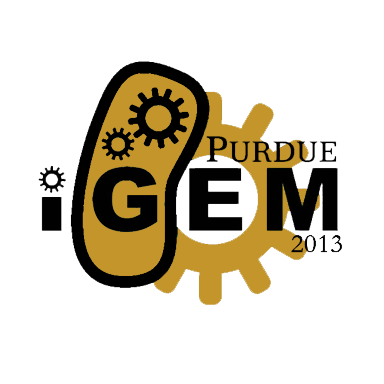Background
Our Girls Scouts initiative began as a conversation between Rebecca Shini, a Greenfield high school teacher, and Tamara Payton, the Central Indiana membership development manager. In their conversation both parties expressed a concern for incorporating Science Technology Engineering and Mathematics (STEM) into the Girl Scouts curriculum based on the then recent “Generation STEM Report” released by the Girl Scouts Research Institute. In particular, Ms. Payton wanted to organize a Biotechnology workshop for her Scouts in Central Indiana but was not sure how to do so. Aware of our enthusiasm and desire to engage budding scientist, Mrs. Schini referred Ms. Payton to the Purdue iGEM team. Together we organized the implemented the following workshop with 6 Girl Scouts ages 9-11 on May 18th 2013.
Goals for the Workshop
- Generate interest in young women about possible careers in science and technology
- Provide female scientist as role models
- Make them feel like scientists
- Discuss how to find more information on STEM
Overview of Workshop Curriculum
The Introduction of Synthetic biology and Biotechnology for students (esp. 3rd-5th grade) is best broken into three target stages:
- Exposure: What is synthetic biology/biotechnology?
- Lecture: Intro to SynBio and what is DNA?
- Relate Concepts to the Real-World:
- Technical: How does synthetic biology/biotechnology work?
- Strawberry DNA Lab
- Implementation: What can we do in synthetic biology/biotechnology?
- Overview of Scientific Method
- The 2012 iGEM project Review: navigating iGEM wikis
We started by describing the different layers of tissue organization; how a cell becomes a tissue , a tissue an organ etc.. What we wanted to do was first, was build a framework of size and how these things relate so that they can visualize them in their heads. We than gave an overview of the central dogma of biology. We focused primarily on proteins. We used keratin in hair, elastin in skin and hemoglobin in blood as tangible examples. One student mentioned how she has seen keratin mentioned on her shampoo. This sparked discussion for how common household products are engineered with a biochemical perspective.
We then played the spider goat clip from the BBC documentary, “Playing God.” We wanted to show how synthetic biology was actively going on in the world. The students were most surprised to find out that the goats were normal and not some crazy looking “mutants” from a sci-fi movie. This sparked conversation on what animals and abilities they would join to make a “super” animal. This was the perfect transition to the fluorescent proteins isolated from jellyfish. They were most surprised by how you can order rabbits and fish that glow in the dark off the internet.
(We then conducted the traditional strawberry DNA isolation Lab. We felt it was important to encourage self-experimentation so we used soap detergent, table salt, and ethanol, all household items. We explained how detergents help break cell membranes and how it’s a process we undergo every time we take a shower. Then we used diagrams to show how salt helps remove proteins attached to DNA. For the precipitation of DNA in ethanol we used the diffusion of salt into water as a counter example. The students were most surprised to see how much DNA was in each cell. They were even more stunned when we revealed that a single genome in any cell can make a whole organism! )
These sessions were more interactive we separated into groups and explored the scientific method. We taught them the basic principles of asking a question, doing background research, constructing a hypothesis, testing it through controlled experiments, analyzing your results and drawing a conclusion. We formulated many practical experiments like how to practice hitting golf ball, how to find the scissors in the classroom and if someone was allergic to something. Our students were surprised when they realized that they naturally used a method to figure things out but now with established structure things flowed a lot faster and easier. We encouraged them to keep journals of their own personal experiments.
To wrap up we gave them a summary of our iGEM project from 2012. While doing this we showed how to navigate wikis. They were most surprised at how we came up with the idea. This was eye opening for us because we felt brainstorming for a meaningful project was the hardest part. We explained to them that how we learn about what others have done and how the challenge of science is using this knowledge to find something new. They remarked about how science was like way of thinking and that finding people who thought about the same thing is different ways was fun. We ended the day by pinning each student with a iGEM badge and welcoming them to a life-long community of scientist!
Pictures of the Workshop
Future Directions
The next time we conduct this workshop we hope to provide before and after assessments to quantitatively determine what our students are learning. We would also like to start a mentoring program by providing avenues for our participants to reach the team for advice. We also want to track where they go so we can help start High school iGEM at their High schools.
 "
"
